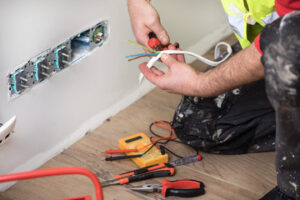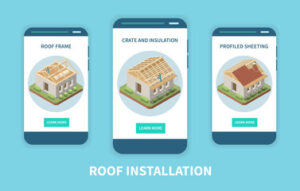Electrical systems in homes, businesses, and factories rely on the work of electricians to function. They are skilled at analyzing electrical problems and finding effective solutions.

Electrician oftens train through a combination of vocational school and apprenticeship programs. Those who complete these programs can earn their journeyman license. Union apprenticeships offer additional benefits like health insurance and paid vacation.
Electrical wiring is the system that transmits electricity throughout your home. It is a non-metallic cable consisting of insulated wires that are colored or marked to indicate their gauge size. The wires can be twisted together or in a bundled group like lamp cord.
Different types of electrical wires are used for different applications. For example, low-voltage wires typically include bell wires for doorbells, thermostat wires and landscape lighting, which require minimal voltage. These wires are small, insulated and covered in a plastic sheathing, similar to lamp cord.
Higher-voltage electrical wiring, also referred to as branch circuit wiring, runs between your electrical service panel and electrical outlets, lights and appliances. It may be stranded or run in conduit, which is a protective tube made of metal (usually steel) or non-metallic material, such as PVC.
Both stranded and insulated wires are usually color-coded. The National Electrical Code sets standard colors for the wires in branch circuits. White or gray wires are designated neutral, while black or red wires carry live current to switches, receptacles and light fixtures. Green or bare copper wires are ground, connecting to a switch box’s green grounding screw or to a grounded outlet box.
It’s important to choose the correct type of wire for each job. If a wire is too thick for the load it’s intended to carry, it can cause a fire hazard. It’s also important to make sure all of your connections are tight and properly secured. Leaving wires exposed or cutting them too short makes them difficult to connect and can lead to poor wiring that poses a serious shock or fire hazard. It’s a good idea to have a licensed electrician do any wiring or work that requires electrical equipment.
Circuit Breakers
Circuit breakers protect the people that utilize electrical systems and the devices that are connected to them. They are not designed to replace operating controls like relays or contactors; they simply open and close circuits to control current flow. Breakers come in a variety of sizes from 15 amps for lighting circuits to 100 or more for a sub-panel that might contain a dryer, water heater, electric heat pump and even a workshop.
A circuit breaker’s ampere rating (marked on the end of the operating handle) is the maximum amount of current it will carry continuously without overheating its conductor terminals or damaging the breaker itself. In order to pass a safety test a breaker must have the ability to interrupt a fault current that is two times its rated ampacity. This is known as the short circuit current interruption capability or AIC.
In order to trip under a short circuit condition the breaker will need to produce either a thermal or magnetic (no intentional delay) trip element that will open the breaker’s switch contacts. It should be noted that a breaker can also be tripped by a reversal of the voltage in its circuit.
When a breaker is installed in a panelboard the breaker is typically mounted using a base that is bolted and wired to the frame and an actual breaker that has insulated parts that electrically mate with the base. This type of mounting allows the breaker to be replaced without having to re-wire it on the line side. As with any breaker it is important to visually inspect the case and connections for overheating indications. A voltage drop test should also be performed from the load center or panelboard’s main lugs to the breaker’s load terminals.
Outlets
The outlets you plug your electrical equipment into complete the circuits needed for them to operate. You may not be familiar with the different types of electrical outlets, but understanding them can help you determine whether your home has the right amount of power for all of the appliances and devices in your house. It can also be beneficial if you decide to upgrade the existing outlets in your home.
Outlets are available in many different shapes and sizes, with each type serving a specific function. For example, there are outlets designed for outdoor use and outlets that protect against electric shocks. An electrician can help you choose the right outlets for your electrical system and ensure they are installed correctly to prevent fires or other dangerous situations.
Most homes in the United States have 3-prong outlets, which are known as 15-amp outlets. They have two vertical slots, with the wider one being neutral and the narrower one being the hot wire. These outlets can be used for most household devices, such as lamps, chargers and audio equipment. However, they cannot be used to power larger appliances like air conditioners or washing machines.
There are also 2-prong electrical outlets, which can be used for smaller devices that require less power. The two parallel flat prongs on a Type B outlet represent the live and neutral connections, but they have an additional grounding pin that helps reduce the risk of electric shock.
GFCI outlets, or ground fault circuit interrupters, work as safety devices by shutting off electricity quickly when they sense a problem. They are especially useful in areas where water is present, such as bathrooms, kitchens and basements, and they can help prevent electrocution.
Switches
Whether it’s the basic on/off functionality of single-pole switches or the more sophisticated control offered by smart switches, electric switches are essential to our everyday lives. They are the unsung heroes that allow us to harness the power of electricity safely and reliably.
There are many different types of electrical switches, and it’s important to select the right switch for a particular application. Key specifications include switching function, voltage and current ratings, as well as the circuit configuration, which refers to the number of poles, throws, and breaks. In addition, switches are rated for their environmental conditions and have different mounting requirements, such as a minimum enclosure rating or an Ingress Protection (IP) rating.
Plain electrical switches have an actuator and an electrical conductor and are often used to control larger appliances or light fixtures in a home. These switches require a separate mechanism to break the circuit if the switch is tripped. Circuit breaker switches are often found in commercial settings, and they differ from plain switches because they are designed to interrupt the flow of electricity when tripped.
There are also special switches, such as AFCIs (arc fault circuit interrupters) that protect against arcing between wires. These devices are installed in place of standard switches in homes and businesses, and they have the ability to detect a short circuit by sensing changes in current. If a faulty outlet is detected, an AFCI will trip the switch to prevent the current from flowing through a live wire and potentially causing fire or injury. AFCIs are more sensitive than standard switches and have a faster response time to detect shorted or overloaded circuits. It’s important to follow simple safety tips when working with electric switches, such as stepping to the side to operate them rather than reaching across a live circuit.
AFCIs
Arc fault circuit interrupters protect homes from electrical fires by shutting off power before a fire starts. They sense small arcs of electricity that can occur when switches and outlets are turned on and off or when brushed motors and lamps with broken cords operate. AFCIs are especially helpful for older homes with knob-and-tube and aluminum wiring, which are more likely to cause electrical fires than modern copper wires.
AFCIs use advanced electronic technology to monitor the electrical current flowing through a circuit. A sensor on the receptacle detects changes in voltage that indicate an arc. If it detects a dangerous arc, it immediately interrupts the flow of electricity to prevent overheating and potential fires.
In addition to detecting arcing, the AFCI also uses a ground current sensor to detect slowly-developing insulation breakdown that could eventually lead to a line-to-ground or a series arc. The ground current signal is amplified and fed into a microprocessor, which analyzes it for abnormalities that may indicate an arcing condition. If the arcing is considered hazardous, a solenoid opens the circuit breaker contacts.
While AFCIs can help prevent electric fires, they cannot replace good housekeeping and regular maintenance of your electrical system. If you have old or damaged wires, they should be replaced by a qualified electrician. A professional electrician will also be able to determine if your home’s service is adequate, or if it needs to be upgraded to 200- or 400-amp service.

